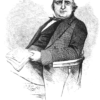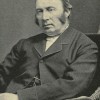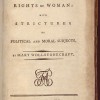
Janice Schroeder, “The Publishing History of Henry Mayhew’s London Labour and the London Poor”
Versions of Henry Mayhew’s massive social survey London Labour and the London Poor appeared in several publishing formats, including newspaper column, weekly serial, live stage show, and bound volume. This article traces the republication and remediation of London Labour alongside Mayhew’s repackaging of his interviews with London “street-folk” from 1849 onwards. I offer a succinct, accessible account of the complex publishing history of the text, from print newspaper column to digital edition.

Kimberly J. Stern, “The Publication of John Pentland Mahaffy’s The Decay of Modern Preaching (1882)”
This contribution to BRANCH documents the historical and biographical conditions surrounding the publication of John Pentland Mahaffy’s controversial volume The Decay of Modern Preaching (1882). Although often deemed to be a secular or even heretical thinker, Mahaffy emerges here as a thoughtful scholar of religion standing at the crossroads of faith and reason. In the years preceding the publication of The Decay of Modern Preaching, Mahaffy witnessed a number of changes at Trinity College Dublin that threatened the principles he deemed essential both to good preaching and to intellectual culture more broadly. Mahaffy’s views on intellectual work and religion were mutually sustaining, a fact that helps to enrich our understanding of this important text, its troubled reception in the nineteenth century, and the evolving narrative of nineteenth-century faith.

Scott C. Thompson, “On G. H. Lewes’s Problems of Life and Mind, 1874—79″
In Problems of Life and Mind (1874—79), George Henry Lewes posits his theory of “Scientific psychology,” which is founded on a synthesis between the objective study of the mind practiced in physiology and the subjective study of consciousness practiced in philosophy. Problems is an important text because it is one of the last quintessentially “Victorian” studies, a wide-ranging work produced before the full establishment of disciplinary boundaries. It combines a variety of discourses—including philosophy, physiology, psychology, evolutionary biology, and sociology—in order to establish a comprehensive methodology for the scientific study of consciousness. This entry positions Problems into its nineteenth-century psychological and philosophical tradition, as understood by Lewes; provides a summary of the overarching argument of Problems; and outlines the contributing sub-claims made in each of its discrete series.

Karen Dieleman, “Aurora Leigh in the Netherlands, 1870-1900″
Elizabeth Barrett Browning’s 1857 verse-novel Aurora Leigh entered the cultural and social-political life of the Netherlands in the 1870s and 1880s through the work of three Dutch people: a literary critic, a social reformer, and a novelist. Conrad Busken Huet, the country’s leading literary and cultural critic, first brought the poem to Dutch attention in 1873 by showcasing it as a model of great art with high social and moral purpose, from which Dutch contemporary poetry could learn. Hélène Mercier, one of the leading social reformers of the country, then translated the poem into Dutch in 1883 to inspire the country’s social reform efforts. Its prophetic voice, Mercier declared, spoke as directly to the social conditions of the Netherlands in the 1880s as it had to those of England in the 1850s. Arguing that it was not necessary to retain Aurora Leigh’s poetic form for this voice to have effect, she translated the poem as prose. But Dutch novelist Martina van Walcheren did not agree. She produced a poetic translation in 1885 that her publisher supported at least in part because he opposed the emerging art-for-art’s sake movement. All these literary, social reformist, and aesthetic developments or debates were also fueled or complicated by national and international book economies and copyright questions.

Kathleen Frederickson, “British Writers on Population, Infrastructure, and the Great Indian Famine of 1876-8”
This article examines British writing about the 1876-8 famine in southern and western India. In British newspapers and journals, the turn to thinking about famine in terms of the total population obscured the extreme variations in food access that worsened with rising economic inequality. When the British press in the late-1870s turned to human causes of famine, they either argued that India’s population overburdened India’s land, or suggested that more rail construction would prevent enough deaths sufficiently to mitigate British responsibility for famine conditions. The turn to population-based arguments helped either to perpetuate the belief that famine was a quasi-natural part of India or to parse the sudden increase in the frequency and severity famines in India under British rule.
![Figure 2: First Scottish colony for New Zealand. [Reprinted] Copyright People’s Palace Museum, Glasgow Green [ca 1981]. Alexander Turnbull Library, Wellington, New Zealand. Ref: Eph-C-IMMIGRATION-1839-01. Used with permission. http://natlib.govt.nz/records/22730739.](https://branchcollective.org/wp-content/uploads/2017/04/2-First-Scottish-Colony-for-New-Zealand-100x100.jpg)
Philip Steer, “On Systematic Colonization and the Culture of Settler Colonialism: Edward Gibbon Wakefield’s A Letter from Sydney (1829)”
In 1829, Edward Gibbon Wakefield published his first statement of a “systematic” theory of settler colonization, A Letter from Sydney: The Principal Town of Australasia. Wakefield offered a novel economic theory of the relationship between population density and successful colonization, hinging on the establishment of a minimum or “sufficient” price on colonial land, and he spent the next few decades at the forefront of efforts to promulgate and profit from it. The theory of systematic colonization was first put into practice in 1836 in the new colony of South Australia, and then more extensively in New Zealand in 1839; in both cases, speculative mania in Britain precipitated the invasion of thousands of settlers, even though the settlements were as yet unmapped. Wakefield’s theories were also at the center of a new imperial imaginary that emerged in Britain by the 1850s, which established Australia and New Zealand as pastoral locations capable of restoring damaged British subjects. In spurring the vast expansion of migration to Australia and New Zealand, contributing to the genocide and dispossession of indigenous populations, and accelerating the destruction of local ecosystems, systematic colonization constitutes one of the most powerful and destructive examples of the ability of Victorian representations to permanently reshape the globe.

Anna Maria Jones, “On the Publication of Dark Blue, 1871-73″
Dark Blue (1871–73) was a monthly magazine, edited by Oxford undergraduate John Christian Freund, which folded two years after a brilliant debut. During its brief run, it brought together a stunning list of literary and artistic contributors, including Dante Gabriel Rossetti, A. C. Swinburne, William Morris, Andrew Lang, Mathilde Blind, Sheridan Le Fanu, Simeon Solomon, and Ford Madox Brown, who produced aesthetically and sexually daring poetry, art, and criticism. However, it also strove to “appeal to the whole English-speaking public,” as Freund put it, and, thus, included much that might be described as middlebrow, even conservative. Whereas individual texts from Dark Blue, such as Le Fanu’s Carmilla, have received considerable attention, scholars have devoted very little sustained attention to the journal beyond noting its importance as an “artifact” in the history of the Pre-Raphaelite Movement and British aestheticism, and registering puzzlement at the journal’s eclecticism. This essay returns to Dark Blue to uncover common threads among dissimilar writers and artists. With particular attention to the journal’s commitments to transnationalism, I trace three intertwined threads—synesthesia, translation, and sexual dissidence—as they manifest in key texts by Swinburne, Solomon, Le Fanu, and others. Reading these texts in their original context not only demonstrates Dark Blue’s importance to early formations of aestheticism but also helps us to see how aestheticism connects with, rather than stands in opposition to, mid-Victorian culture.

Jane Stabler, “Religious Liberty in the ‘Liberal,’ 1822-23”
A survey of the negative twentieth- and twenty-first-century critical reception of the Liberal; a summary of the history of the journal and a re-evaluation of the philosophical and political coherence of the journal, focusing on its defence of religious liberty and suggesting that religious free thought is a previously overlooked component in the politics of liberalism. The criticism of doctrinal rigidity and advocacy of different forms of religious toleration evident in the four issues of the Liberal support the claim that the journal forms a lucid and intelligible cultural intervention.

Eleanor Courtemanche, “On the Publication of Fabian Essays in Socialism, December 1889″
The Fabian Essays, published in 1889 by an intellectual London club called the Fabian Society, aimed to make socialism palatable to a largely suspicious British public and became a surprise bestseller. The volume was edited by George Bernard Shaw, who was a leading figure in the Fabian Society before his career as a dramatist. In the Fabian Essays, the Fabians distanced themselves from the insurrectionary radicalism of both Hyndman’s Social Democratic Federation and Morris’s Socialist League, claiming instead that Britain was inevitably and gradually evolving into a sensible socialist state. The Fabians’ advocacy of pragmatic socialist parliamentary politics helped pave the way for the rise of the Labour Party in 1900.

Anne Mellor, “On the Publication of Mary Wollstonecraft’s A Vindication of the Rights of Woman“
Mary Wollstonecraft’s Vindication of the Rights of Woman (1792) laid out the tenets of what today we call ‘equality’ or ‘liberal’ feminist theory. She further promoted a new model of the nation grounded on a family politics produced by egalitarian marriages.
